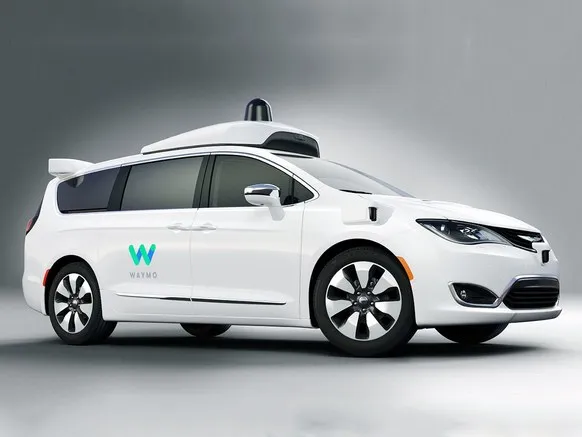A self-driving car may be in your near future, if you live in the right place.
. . . . . . . . . . . . . . . . . . . . . . . . . . . . . . . . . . . . . . . . . . . . . . . . . . . . . . . . . . . . .
Terence Plizga
November 8, 2017
Waymo, the self-driving vehicle company spun off from Google Alphabet, will start deploying a driverless ride-hailing taxi service in portions of Phoenix, Arizona in the next couple of months. Members of the public will be able to hail robotic Chrysler Pacific minivans using a smartphone app. The current fleet, now used for testing, will be increased from 100 to 500 vehicles.

Credit: Waymo
Departing now from their previous test protocol, Waymo states that the taxis will not have human safety drivers. A Waymo employee will ride along with the passenger in the backseat. However, after an initial trial period, the passengers will ride alone. An emergency stop button will be available to the passenger just in case there are any malfunctions.
During the trial period, the driverless taxi service will be free. The company intends to collect data about how the human passengers use the new service: origination points, destinations, times of day, traffic conditions. To a certain extent, this first set of customers will be beta testers.
Service will be limited to the cities of Chandler, Mesa, Tempe and Gilbert. This is basically the southeastern portion of the Phoenix metropolitan area.
Because the vehicles are still plagued with performance issues during inclement weather, expect the robotaxis to be taken offline on rainy days.
Waymo's fleet is not the first autonomous vehicle out of the gate. Uber AI Labs deployed self-driving cars in September in Pittsburgh, Pennsylvania. Uber has also been testing vehicles in San Francisco, California and Tempe, Arizona. Waymo and Uber are proving to be fierce competitors.
Waymo is also testing vehicles in other cities, including San Francisco, Seattle, and Austin. There are rumors that they are interested in a partnership with Fiat Chrysler.
Other competitors include drive.ai and General Motors.
Are We Ready for This?
Well, that's a good question. I've written in the past about the current limits of machine learning algorithms. We currently use convolutional neural networks (CNNs) to perform visual tasks such as object recognition. But they require massive numbers of video captures before they can start recognizing the best response to a given visual scenario (e.g., merging lanes, pedestrian crossing street, broken-down bus blocking lane). And it's practically impossible to create enough test images for a CNN to learn what every possible emergency situation looks like.
Even if it could recognize all emergency situations, a state of the art AI lacks sentience. It cannot appreciate the consequences of its actions, such as whether pedestrians or other drivers are likely to be injured as the result of one of its decisions. Nor can it evaluate ethical issues when forced to choose among a series of hopeless options, all of which lead to death or serious physical injury.
So, what do you think? Are we ready?
References:
- Reuters, Alphabet's Waymo to launch robotaxis with no human in driver's seat
- NY Times, Waymo to Offer Phoenix Area Access to Self-Driving Cars
- Wired, Waymo Has Taken the Human Out of its Self-Driving Cars
- NY Times, No Driver? Bring It On. How Pittsburgh Became Uber’s Testing Ground
- Ars Technica, What it’s like to live in Phoenix? “Waymo units all over the damn place”
Related Articles:

|

|

|
| Self-Driving Cars No Longer Fear Inclement Weather at Night | New Theory May Explain Why Neural Networks Work | We Need to Stop Putting Blind Faith into Big Data |
SteemSTEM Writers Group
Would you like to support scientists on Steemit? Are you a scientist? Then join the #steemSTEM channel on steemit.chat and connect with us!
STEM is an acronym for Science, Technology, Engineering, and Math.